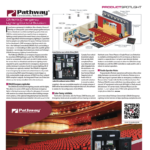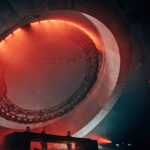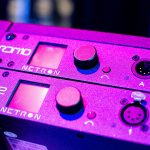Traditional Tungsten
In the world of entertainment lighting, one category of incandescent lighting fixtures seemed, for a while at least, to be particularly resistant to the move toward LEDs: Ellipsoidal fixtures with traditional tungsten bulbs.
In the early days of LED technology, most lighting designers would argue that the superior quality of light achieved by incandescent tungsten Ellipsoidal fixtures easily outweighed such concerns as fixture operating temperatures, frequency of bulb changes or overall energy usage.
But if that meant ETC wasn’t the first lighting manufacturer to scramble aboard the LED bandwagon, the company didn’t ignore the LED trend for long.
 The Selador Legacy
The Selador Legacy
In 2009, ETC made its first big move toward LED lighting with its acquisition of the Selador LED product line, giving ETC access to Selador’s Paletta, Vivid and Lustr LED technologies. By mid-2011, ETC was providing the first glimpse of its Source Four LED prototype — not the fixture itself, but its output. (The fixture itself, hidden from view, lit CEO Fred Foster as he discussed LED lighting at a company conference).
Within a year, ETC was cranking up production of its Daylight, Tungsten and Lustr+ Source Four LEDs, extending the 20-year legacy of the Source Four brand into the LED era. While the light source was radically different, these fixtures otherwise paralleled their traditional counterparts in look, functions and operation.
Same Lens Barrels, Optics
Although the rear of the LED fixtures had to be redesigned to make room for the LED light source, which adopted the X7 color mixing system from the Selador line of LED strip lights, the new Source Four LED fixtures used the same shutter blade, lens barrel and optics as ETC’s traditional Source Four fixtures.
Selador’s X7 color mixing system first drew notice for its ability to generate hues that were not attainable with the earliest RGB LED configurations. The “7” refers to seven colors — Red, Red/Orange, Amber, Green, Blue, Cyan and Indigo.
A New Color-Mixing Twist
This year, ETC updated the Selador X7 color mixing system with a new twist — lime. Lime green LEDs, the company says, add to the overall lumen output in open white and lighter tints, making the new Source Four LED Series 2 Lustr brighter and livelier than their Source Four LED predecessors. An added bonus is that lime green LEDs help the Series 2 fixtures match the color of a traditional Source Four tungsten fixture.
ETC says lime also enhances color rendering by helping the red and blue ends of the color spectrum work better together at achieving true-to-life colors. And by tweaking its red LEDs, ETC says its Series 2 fixtures are even better at producing ambers, straws and pinks, making those hues look up to three times as bright as the original Source Four LED fixtures.
Color Mixing Algorithms
To meet the needs of designers and programmers who are not only looking to achieve the ideal hue, but do so quickly, ETC has developed a color algorithm that promises to optimize the speed of the Source Four LED Series 2’s color mixing system. The company says that, simply by using Hue, Saturation and Brightness or Red Green Blue controls on a lighting console, the fixtures will do the rest, automatically tweaking ratio of lime, red and the other five LED colors used in the mix.
Saving Energy and Money
As with its original Source Four LED fixtures, which are still available, the newer Source Four LED Series 2 fixtures offer considerable long-term cost savings by powering up with a much higher degree of energy efficiency. One clear example of the potential advantages: nine Source Four LED Series 2 fixtures can be safely daisy chained together on a single 15A circuit, using the fixture’s PowerCon connections. Compare that to a 575W tungsten version — where only three of the fixtures could safely go on that same circuit.
Along with the daisy-chaining advantages, of course, LED technology opens the door to other cost savings, ranging from lower maintenance costs (the 60 Luxeon Rebel LED emitters have a L70 Rating of 20,000 hours of use) , cooler operating temperatures (which can also significantly reduce HVAC costs for the venue) and solid-state durability, among other benefits.


